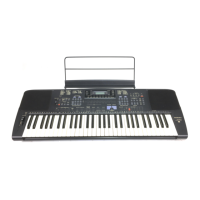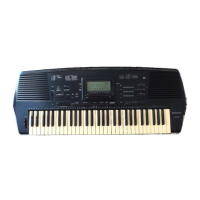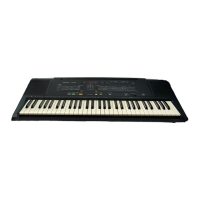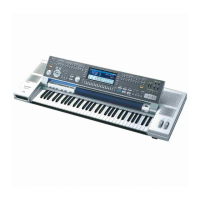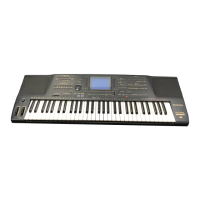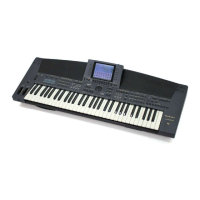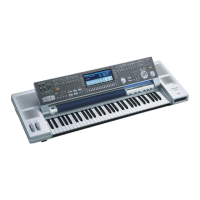
Do you have a question about the Technics SX-KN930 and is the answer not in the manual?
| Display | LCD |
|---|---|
| MIDI | Yes |
| Headphone Jack | Yes |
| Floppy Disk Drive | Yes |
| Polyphony | 32 Notes |
| Rhythms/Styles | 100 Rhythms |
| Effects | Reverb, Chorus |
| Connections | MIDI In/Out |
| Power Supply | AC Adapter |
Details mains lead wire colors and fuse rating for safe replacement.
Step-by-step guide for replacing a blown fuse in the mains plug.
Warning against exposing the product to rain or moisture to prevent fire or shock.
Advises reading cautionary notes on preceding and current pages before operation.
Specifies ideal placement for ventilation, avoiding direct sunlight, heat, and dust.
Warns about metal objects, water, and touching internal parts to prevent shock.
Covers maintenance advice, power cord handling, and abnormal operation remedies.
Details placement, power source, and handling of the power cord for safe operation.
Addresses risks from metal items, water, internal parts, and provides maintenance tips.
Illustrates and labels key controls like Sequencer, Auto Play Chord, and Display.
Highlights Pitch Bend, Manual Sequence Pads, and One Touch Play functions.
Explains Transpose, Number Pad, and Effects controls.
Details Panel Memory, Techni-chord, and Conductor functions.
Illustrates and labels controls for Sequencer, Composer, Auto Play Chord, and Display.
Highlights Pitch Bend, Manual Sequence Pads, One Touch Play, and Sound Edit functions.
Explains Transpose, Number Pad, and Effects controls.
Details Techni-chord, Conductor, and Backup Memory functions.
Illustrates and labels controls for Sequencer, Composer, Auto Play Chord, and Display.
Highlights Pitch Bend/Modulation, Manual Sequence Pads, One Touch Play, and Sound Edit.
Explains Transpose, Number Pad, and Effects controls.
Details Techni-chord, Conductor, and Backup Memory functions.
Guides on battery usage, AC adapter connection, and music stand setup.
Outlines essential steps for turning on, selecting parts, and adjusting volume.
Details plugging in the power cord and affixing the music stand.
Outlines essential steps for turning on, selecting parts, and adjusting volume.
Explains how to play, stop, select, and control demonstration songs.
Details using the SOUND/PART button and number pad to choose instrument sounds.
Explains how to add spaciousness (Digital Effect) and sustain to sounds.
Covers adding chorus for breadth and DSP effects for unique sonic qualities.
Describes adding digital reverb and altering pitch using the Pitch Bend wheel.
Guides on starting, stopping, and selecting variations for automatic rhythms.
Explains how to adjust tempo and insert intro, fill-in, and ending patterns.
Guides on starting, stopping, and selecting variations for automatic rhythms.
Explains tempo adjustment and insertion of intro, fill-in, and ending patterns.
Details how to use Auto Play Chord with a tune and select fingerings.
Describes how panel settings match selected styles when using One Touch Play.
Guides on using the Sequencer and Easy Record for performance recording.
Details how to play back recorded performances and stop the playback.
Explains inserting disks and initiating playback via Memory & Control and PAGE buttons.
Notes that direct play from SMF Format 0 disks is not possible and directs to SMF LOAD procedure.
Describes the standard information shown on the display, including tempo and sound selection.
Explains how to view and adjust volume balance and use the MUTE function.
Details how PAGE buttons are used to navigate through different display pages.
Explains how to access and use menu displays like MEMORY & CONTROL.
Describes how to adjust settings displayed on the screen.
Guides on selecting sounds for the keyboard parts using the SOUND/PART button.
Details how to assign sounds to LEFT, RIGHT 1, and RIGHT 2 parts using CONDUCTOR buttons.
Explains how to set a different split point note for the keyboard sections.
Describes applying Digital Effect for richness and Chorus for breadth.
Details applying DSP effects for unique quality and Sustain for tone duration.
Explains applying digital reverb and controlling pitch with the Pitch Bend wheel.
Describes using the Modulation wheel to add vibrato to the sound.
Explains how to raise or lower the key of the entire instrument.
Details how to adjust the key using Transpose buttons and shows actual key examples.
Guides on turning on Techni-chord to add harmony to melodies.
Explains how to select different harmony styles for Techni-chord.
Describes using Orchestrator to assign sounds to melody and harmony notes.
Explains how to use the Manual Sequence Pads to play phrases.
Guides on recording phrases using Tempo/Progam dial and Record/Stop button.
Details how to select rhythms using the Rhythm button and number pad.
Explains immediate and synchronized start methods for rhythms.
Covers adjusting tempo using Tempo/Program dial and Tap Tempo.
Describes how to use intro, count intro, and fill-in patterns for performance.
Explains ending patterns and the Auto Play Chord function.
Details how Auto Play Chord works and its chord playing modes.
Explains the One Finger and Fingered modes for playing chords.
Describes the On Bass and Memory functions for Auto Play Chord.
Provides step-by-step instructions for using the Auto Play Chord and Break functions.
Guides on using the Sound Arranger to set and play back sounds.
Explains how to set up and use the One Touch Play feature for registrations.
Guides on selecting music styles and their associated settings.
Explains how to use the Music Style Arranger for registration changes.
Details how to change music styles mid-performance.
Guides on storing panel settings like sounds, volumes, and effects.
Explains how to use the Panel Memory mode and expand filter.
Details how to assign various functions to the optional Foot Switch.
Introduces the Sequencer's capabilities for recording and playback.
Outlines the menu items available within the Sequencer, such as P1, P2, P3.
Guides on selecting, naming, and saving songs within the Sequencer.
Explains the steps for quick recording and playback using Easy Record.
Lists and describes the parts that can be assigned within the Sequencer.
Guides on recording performances in realtime with timing accuracy.
Explains how to record musical phrases continuously using Cycle Record.
Guides on selecting songs and tracks for playback.
Explains how to set up and perform cycle playback of selected tracks.
Guides on recording chord progressions using the Step Record feature.
Details storing, correcting, and managing chord data.
Guides on storing, correcting, and managing rhythm data.
Explains how to assign tracks to different parts using the Track Assign feature.
Guides on selecting functions like Song Clear and Track Clear for editing.
Explains how to erase recorded songs.
Guides on clearing tracks and correcting timing with Quantize.
Explains how to copy songs and write panel settings.
Guides on selecting and playing back songs in a medley.
Introduces the Composer's capabilities for creating accompaniment patterns.
Details the options available within the Composer Record menu.
Guides on copying and preparing to edit existing rhythm patterns.
Explains the steps for creating completely new rhythm patterns.
Details setting up rhythm patterns, time signatures, and naming them.
Guides on adjusting tempo, selecting sounds, and recording rhythm parts.
Explains how to play back recorded composer patterns in different modes.
Details how to adjust the pitch bend range for accompaniment and bass parts.
Guides on creating, selecting, and naming chord maps for accompaniment.
Explains how to recall stored chord maps for use with performances.
Guides on saving performances to memory or disk.
Explains how to load stored performances from memory or disk.
Introduces the capabilities of the internal memory and floppy disk drive.
Details the main parts and general procedures for disk drive operations.
Guides on loading data in various formats like Technics File, SMF, and Composer.
Explains loading data saved in Technics File and SMF formats.
Guides on using Direct Play to play commercial song disks.
Explains the process of formatting floppy disks for use.
Guides on saving performance data, Technics files, and SMF files to disk.
Explains how to delete specific files from the disk.
Guides on saving SMF data and individual songs to disk.
Continues file deletion and SMF saving procedures.
Details saving SMF data, naming new files, and saving songs.
Explains the procedure for deleting SMF files.
Introduces the Sound Setting mode for fine-tuning sounds.
Guides on adjusting Pan, Reverb, DSP Effect, and Sustain for each part.
Explains how to set Sustain, Key Scale, and adjust Touch & Tune.
Details how to adjust key scaling and user-defined tuning.
Explains how to set the Left Hold mode for Auto Play Chord performance.
Introduces the Sound Edit mode for creating new sounds.
Guides on naming new sounds and writing them to memory.
Explains how to set the octave shift for keyboard parts.
Details adjusting Digital Effect type and Vibrato parameters.
Guides on selecting and adjusting tone parameters.
Explains how to adjust pitch and mixer settings like volume and balance.
Guides on adjusting sound envelopes for attack, decay, and sustain.
Explains what MIDI is and its terminals for data exchange.
Details how MIDI channels are assigned to parts.
Explains the General MIDI standard for data compatibility.
Lists and describes the various MIDI functions and their page references.
Guides on setting MIDI channels and common MIDI parameters.
Explains setting parts and controlling MIDI messages.
Provides details on common MIDI settings like Program Change and GM Mode.
Guides on enabling/disabling control messages and setting parameters.
Explains settings for input/output data like Chord, Drums, and Transpose.
Details Realtime Message commands and MIDI Preset settings.
Guides on setting and enabling General MIDI mode.
Explains procedures for transmitting and receiving data via Bulk Dump.
Guides on resetting the instrument to factory preset conditions.
Lists optional accessories like Expression Pedals and Foot Switches.
Details connections for Foot Switch, Phones/Line Out, and MIDI.
Details connections for Expression Pedal, Foot Switch, Line Out, Phones, and MIDI.
Lists common problems like button malfunction, no sound, and their remedies.
Addresses issues like storage not possible, noise from disk drives, and cabinet warmth.
Provides a list of error codes and their descriptions for troubleshooting.
Lists further error codes and their associated problems and remedies.
